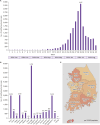Pertussis in the Post-COVID-19 Era: Resurgence, Diagnosis, and Management
- PMID: 40183651
- PMCID: PMC11972920
- DOI: 10.3947/ic.2024.0117
Pertussis in the Post-COVID-19 Era: Resurgence, Diagnosis, and Management
Abstract
Pertussis is endemic worldwide, with epidemics occurring every 2 to 5 years despite a high vaccination coverage. After limited circulation during the coronavirus disease 2019 (COVID-19) pandemic, pertussis cases have increased rapidly worldwide since mid-late 2023, returning to pre-pandemic patterns. In Korea, 90 cases of pertussis were reported from April 2020 to May 2023, with elderly individuals aged ≥65 years accounting for 48.9%. Pertussis cases have increased sharply since June 2024, showing a nationwide epidemic, with a large increase among adolescents aged 13-15 years. As of August 2024, the national incidence rate of pertussis was estimated to be 37.75 per 100,000 population, with the highest incidence of 526.2 per 100,000 population in 13-year-olds. In Europe, during 2023-2024, an increase in pertussis incidence among infants was observed, along with large increases in 10-19-year-olds. In China, the number of reported cases of pertussis has increased rapidly since late 2023, with an age shift to older children, increase of vaccine escape, and a marked increase in the prevalence of macrolide-resistant Bordetella pertussis. The recent global resurgence of pertussis is due to decreased opportunities for boosting immunity by natural infection during the COVID-19 pandemic in combination with waning of immunity-induced pertussis vaccines.
Keywords: Bordetella pertussis; Epidemiology; Whooping cough.
© 2025 by The Korean Society of Infectious Diseases, Korean Society for Antimicrobial Therapy, The Korean Society for AIDS, and Korean Society of Pediatric Infectious Diseases.
Conflict of interest statement
No conflict of interest.
Figures





Similar articles
-
Molecular epidemiology of Bordetella pertussis and analysis of vaccine antigen genes from clinical isolates from Shenzhen, China.Ann Clin Microbiol Antimicrob. 2021 Aug 18;20(1):53. doi: 10.1186/s12941-021-00458-3. Ann Clin Microbiol Antimicrob. 2021. PMID: 34407803 Free PMC article.
-
Pertussis upsurge, age shift and vaccine escape post-COVID-19 caused by ptxP3 macrolide-resistant Bordetella pertussis MT28 clone in China.Clin Microbiol Infect. 2024 Nov;30(11):1439-1446. doi: 10.1016/j.cmi.2024.08.016. Epub 2024 Aug 28. Clin Microbiol Infect. 2024. PMID: 39209267
-
[Monitoring of a whooping cough epidemic 1994/95 in Switzerland using the sentinel notification system. Sentinella Registry].Schweiz Med Wochenschr. 1996 Aug 24;126(34):1423-32. Schweiz Med Wochenschr. 1996. PMID: 8848704 German.
-
Bordetella pertussis in School-Age Children, Adolescents and Adults: A Systematic Review of Epidemiology and Mortality in Europe.Infect Dis Ther. 2021 Dec;10(4):2071-2118. doi: 10.1007/s40121-021-00520-9. Epub 2021 Aug 26. Infect Dis Ther. 2021. PMID: 34435338 Free PMC article. Review.
-
Bordetella pertussis in School-Age Children, Adolescents, and Adults: A Systematic Review of Epidemiology, Burden, and Mortality in Asia.Infect Dis Ther. 2021 Sep;10(3):1115-1140. doi: 10.1007/s40121-021-00439-1. Epub 2021 Apr 29. Infect Dis Ther. 2021. PMID: 33928533 Free PMC article. Review.
Cited by
-
Hemodynamic and neurological presentations of invasive meningococcal disease in adults: a nationwide study across 100+ French ICUs : The RETRO-MENINGO study.Intensive Care Med. 2025 Sep;51(9):1587-1602. doi: 10.1007/s00134-025-08043-4. Epub 2025 Aug 12. Intensive Care Med. 2025. PMID: 40794167
-
Resurgence of Pertussis in the Autonomous Province of Vojvodina, Serbia: Shifting Seasonality, Age Patterns, and the Need for Booster Immunization.Vaccines (Basel). 2025 Jul 31;13(8):814. doi: 10.3390/vaccines13080814. Vaccines (Basel). 2025. PMID: 40872901 Free PMC article.
-
Atypical Presentation of Bordetella pertussis in a Six-Month-Old with Cleaved Lymphocytes and Mild Respiratory Distress.Cureus. 2025 Jun 5;17(6):e85395. doi: 10.7759/cureus.85395. eCollection 2025 Jun. Cureus. 2025. PMID: 40621272 Free PMC article.
-
Reply: Response to Pertussis in the Post-COVID-19 Era: Resurgence, Diagnosis, and Management.Infect Chemother. 2025 Jun;57(2):329-330. doi: 10.3947/ic.2025.0014. Epub 2025 May 7. Infect Chemother. 2025. PMID: 40490386 Free PMC article. No abstract available.
-
Bistability and complex bifurcation diagrams generated by waning and boosting of immunity.J Math Biol. 2025 Aug 22;91(3):30. doi: 10.1007/s00285-025-02264-3. J Math Biol. 2025. PMID: 40844643 Free PMC article.
References
-
- Cherry JD, Harrison GJ, Kaplan SL, Steinbach WJ, Hotez PJ. Feigin and Cherry's textbook of pediatric infectious diseases. 8th ed. Philadelphia: Elsevier; 2019. pp. 1159–1178.
-
- Orenstein WA, Offit PA, Edward KM, Plotkin SA. Plotkin’s Vaccines. 8th ed. Philadelphia: Elsevier; 2023. pp. 763–815.
-
- World Health Organization (WHO) Pertussis vaccines: WHO position paper - September 2015. Wkly Epidemiol Rec. 2015;90:433–458. - PubMed
-
- Domenech de Cellès M, Rohani P. Pertussis vaccines, epidemiology and evolution. Nat Rev Microbiol. 2024;22:722–735. - PubMed
Publication types
LinkOut - more resources
Full Text Sources
Research Materials
Miscellaneous

